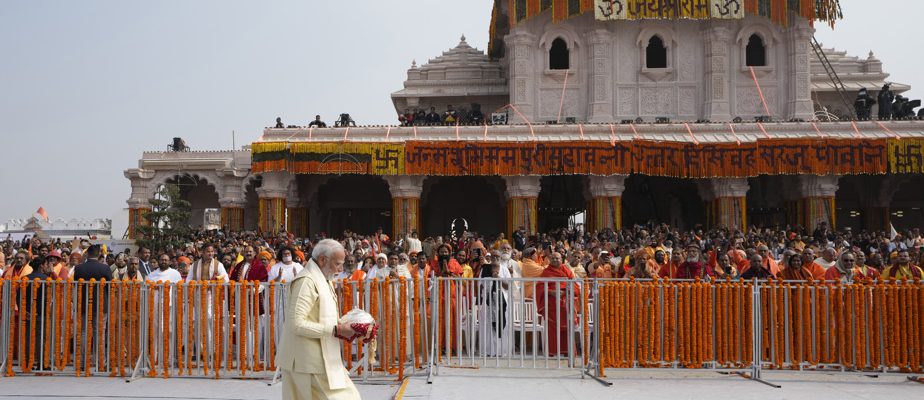(Ayodhya) Indian Prime Minister Narendra Modi inaugurated a temple in the north of the country on Monday symbolizing the triumph of his Hindu nationalist policy, on a site formerly occupied by a mosque whose destruction had triggered violent religious riots.
The prime minister unveiled a black stone statue dedicated to god Rama, adorned with flowers and precious stones, at the heart of the new 50-metre-high temple in the city of Ayodhya.
“January 22, 2024 is not just a date on the calendar, but heralds the advent of a new era,” he said.
This temple was built on the former site of a mosque which had been demolished by Hindu fanatics in 1992. This destruction, encouraged by members of the ruling party, had then triggered the worst religious riots in the country since the independence, leaving around 2,000 dead, most of them Muslims. It also undermined India’s officially secular politics.

PHOTO RAJESH KUMAR SINGH, ASSOCIATED PRESS
View of the crowd attending the inauguration ceremony
“By breaking the chains of slavery, the country must rise again, learning the lessons of the past,” declared the Prime Minister. “Only in this way can a country create a new history.”
Outside, tens of thousands of worshipers singing and dancing, waving flags, honking horns and beating drums, filled the city streets under a shower of flower petals showered by military helicopters.
For the ruling Hindu nationalist party, the Bharatiya Janata Party (BJP), the opening of the Ram Mandir temple crowns several decades of efforts to refocus the country’s politics on the majority religion. It is also a way of unofficially launching the campaign for the re-election of Narendra Modi.
Flow of pilgrims
Around 2,500 musicians were to perform on more than 100 stages in front of the crowds of pilgrims.

PHOTO ADNAN ABIDI, REUTERS
Devotees chant religious slogans while watching the inauguration of the Hindu temple on the big screen.
Many of the latter walked for days to reach the temple, the construction of which cost around $240 million, financed by public donations according to authorities.
Vijay Kumar, 18, took four days to reach the city after covering 600 kilometers on foot and hitchhiking. “We wanted to be here,” he said. “We just want to see the temple before we leave.”
The 140 kilometers that separate the temple from the city of Lucknow, the capital of the state of Uttar Pradesh, are lined with panels depicting the blue-skinned god Rama with a bow and arrows, as well as portraits of Narendra Modi and the region’s chief minister, Hindu monk Yogi Adityanath.
“Some say the event is being used to take an electoral turn. So be it. At least they are doing what they promised and we must have the power to do things for the people,” said Prem Sharan, a 35-year-old resident of Ayodhya.
Other pilgrims arrived via the newly built international airport and will stay in new hotels planned to accommodate the millions of pilgrims expected each year.
Several celebrities were expected to attend the ceremony, including former national cricket team captain Virat Kohli and Bollywood film star Amitabh Bachchan.
” Destruction ”
Narendra Modi and the BJP have sought to promote Hinduism and bring it to the forefront since coming to power a decade ago.

PHOTO OFFICE OF THE PRIME MINISTERVIA REUTERS
Indian Prime Minister Narendra Modi inside the temple
Hindus believe that Rama, one of the most revered gods in the pantheon, was born in the city of Ayodhya over 7,000 years ago and that the Babri Mosque was built at his birthplace by a Muslim emperor of the XVIe century.
BJP leaders regularly describe periods of Islamic rule over parts of India as “slavery” that oppressed Hindus, using the example of Ayodhya to support this narrative.
The BJP played a key role in the campaign that resulted in the destruction of the mosque, even though it was not in power, by organizing processions across the country that sparked multiple religious riots in their wake.
The inauguration of the temple by Narendra Modi alongside Hindu priests should strengthen his position as defender of the faith, before the legislative elections in April.
The BJP is heavily favored to score a third consecutive victory, thanks in part to the prime minister’s pro-Hindu policies.
Opposition parties are boycotting the ceremony, claiming that it is an electoral event.
Among the 200 million Indian Muslims, already worried after an increase in inter-religious tensions, many are observing the event with apprehension.
Mohammed Shahid, a 52-year-old Muslim, recalls how his father was burned alive by a Hindu mob during the violence that broke out in the city more than three decades ago.
“For me, the temple symbolizes nothing other than death and destruction,” he said.
